This post will be taking a look at Christina, Queen of Sweden from 1633 to 1654, who was born today in 1626 (O.S. 8th December). The daughter of Gustav II Adolph (Gustav Adolphus of Sweden) and Maria Eleonora of Brandenburg; following her father’s death at the Battle of Lützen in 1632, Christina took the Swedish throne aged only six.
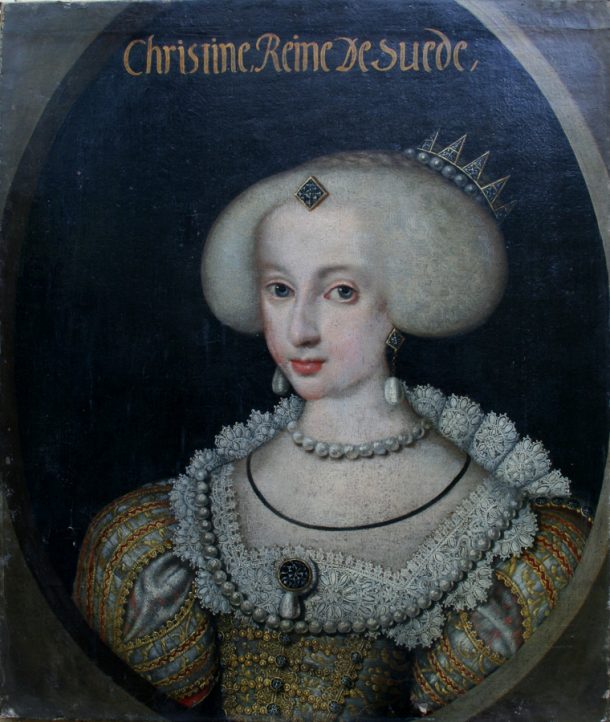
Before leaving to fight in the Thirty Years War, Christina’s father ensured that she would succeed him to the throne and that she would receive an education of the type usually only afforded to boys. She was tutored by the theologian John Matthiae Gothus, a professor from the Uppsala University, and a number of accounts record her bright intelligence, and interest in reading, religion, alchemy, and science.
Christina was noted for her patronage of art, literature, and music and aimed for Stockholm to become the ‘Athens of the North’. Her collections were partly based on the 1648 ‘war booty’ acquired when her troops stormed the Imperial collections in Prague. This was undertaken at her personal request, and objects from Prague were incorporated into her own collections, which already included coins and medals, paintings, antique sculpture, gems and books. The importance of Christina’s collections was widely acknowledged and her discrimination much admired.
In childhood, Christina was by all accounts what today might be called a ‘tom-boy’ but by adulthood, her gender identity appears to have become more ambiguous. Her ‘abnormal’ interest in pursuits normally reserved for males, occasional dressing in male attire, and persistent rumours about her personal relationships, have led to many disagreements among historians as to the nature of her gender sexual identity.

Historical accounts of Christina often include reference to her physical appearance (short, pock-marked and with a hunched shoulder), mannerisms and choice of dress. According to Edward Browne (1665), she regularly wore a velvet justacorps, cravat and man’s perruke. Christina’s contemporary John Bargrave described her comportment as particularly manly and the Duc de Guise (probably Henry II, Duke of Guise) recorded that ‘she wears men’s shoes and her voice and nearly all her actions are masculine’. Accounts such as this no doubt make Christina a more intriguing and interesting character, however it has been speculated that references to her physical attributes may be over-represented in recent studies (creating an impression that this was of greater interest to her contemporaries than was really the case).
It was expected for Christina to provide an heir to the Swedish throne but, as she revealed in her autobiography, she found the ordinary expectations for a woman quite disagreeable. She wrote that she felt, ‘an insurmountable distaste for marriage’ and ‘an insurmountable distaste for all the things that females talked about and did’.
In 1654, after ten years of rule and following her secret conversion to Roman Catholicism, she abdicated. On renouncing her throne, she left the country and travelled to Rome disguised as a man. As a significant convert to the Catholic faith, Pope Alexander VII received into Rome her with great splendour.
In his Vita del Cavalier Giovanni (The Life of Gianlorenzo Bernini), Rome (1713), Lorenzo Bernino reports that Bernini designed the carriage in which Queen Christina made her state entry into Rome. Christina was a great admirer and friend of Bernini and Bernino also quotes her as saying “Whoever does not esteem Bernini is not worthy of esteem himself”.
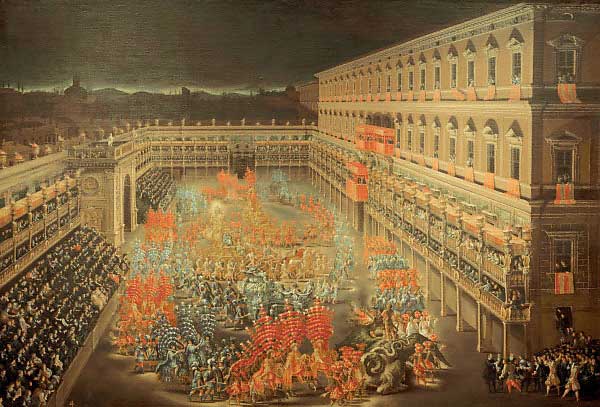
Christina adopted the baptismal name of Maria Christina Alexandra and spent the remaining years of her life based in Rome where she led an independent and unconventional life. Her palace, the Riario (now the Corsini, on the Lungara in Rome), contained a great collection of paintings sculpture and medallions and became a lively, cultural salon. Her enormous collection of books and manuscripts is now held in the Vatican library. She founded the Arcadia Academy (Accademia dell’Arcadia) for philosophy and literature and was also renowned for her militant protection of personal freedoms.
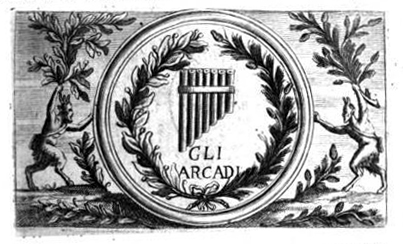
Christina died on 19th April 1689. Despite her having apparently requested a simple burial, the pope insisted on her being displayed on a lit de parade for four days and for there to be a great ceremonial procession. She also became one of only three women granted the honour of burial in St Peter’s.
Christina’s presence in the new Europe Galleries will be through this print, designed and engraved by the Flemish printmaker, Robert van Audenarde and published by Giovanni de Rossi in Rome. It depicts the funeral procession of Christina, former Queen of Sweden, which took place in Rome on the 23rd April 1689.

The procession of mourners begins at the Church of Santa Maria in Vallicella at the bottom right of the print, where Christina’s body had lain in state prior to the funeral, and snakes away to the Basilica of St Peter in the top left hand corner. Groups of onlookers are shown at the side of the image giving a sense of the crowds who must have come to witness the funeral.
The Queen’s carriage is at the end of the procession by the church of Santa Maria and her body appears on her coffin clothed in state robes in the second tier of the procession.
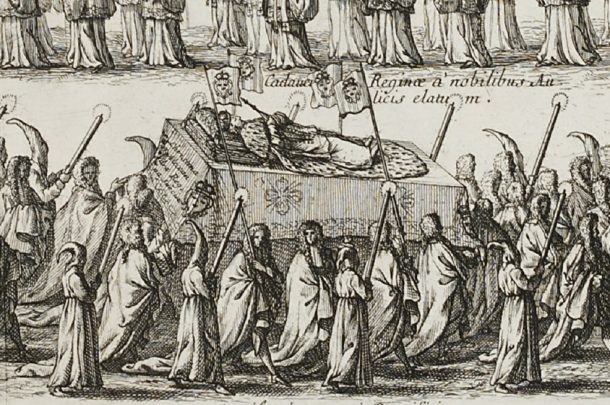

Christina has continued to capture the imagination for more than three centuries since her death and there are a number of objects which reflect this in the V&A’s collections.
This small historicising bust was made around 1730-1750. It may have been part of a larger series of monarchs of Sweden and have been based on a historic painting or engraving but the style implies a 19th-century date.
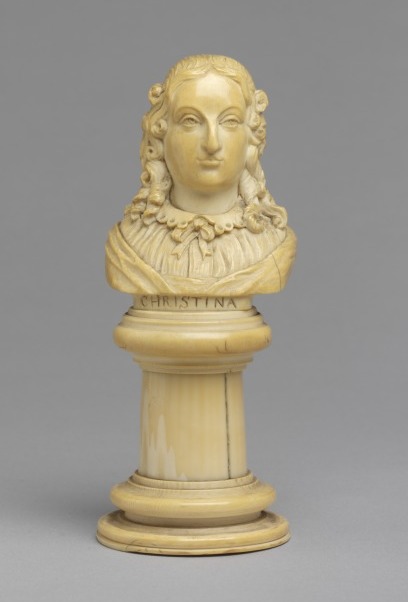
This design for a plate was produced in 1932-33 for Kenneth Clark (later Lord Clark), who commissioned a large dinner service to be decorated by the painters Vanessa Bell and Duncan Grant. The theme for the service was ‘Famous Women’ and the designs ranged from Sappho to Greta Garbo. Vanessa Bell sketched her first rough ideas for this portrait in pencil, before filling in and developing the design with bold strokes of watercolour. This, with a number of other designs for the set and two of the plates were recently shown in Tate Britain’s exhibition ‘Kenneth Clark: Looking for Civilisation’ (20 May – 10 August 2014).

Coincidentally, this design was produced at around the time that the famous MGM film Queen Christina, starring Greta Garbo in the title role, was released. Although ‘short on fact and large on fiction’, I would still say that this beautiful film is worth a viewing on its own terms.

During the 20th century, Christina also featured on commemorative Finish stamps, recognising her role in the establishment of the Finnish Postal System and as the Founder and Patron of the University of Helsinki.
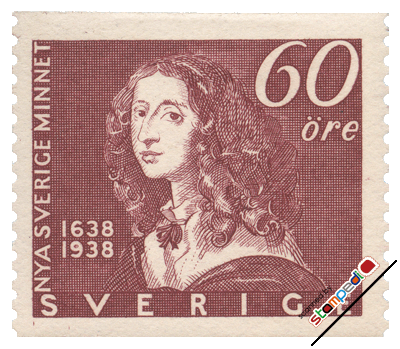
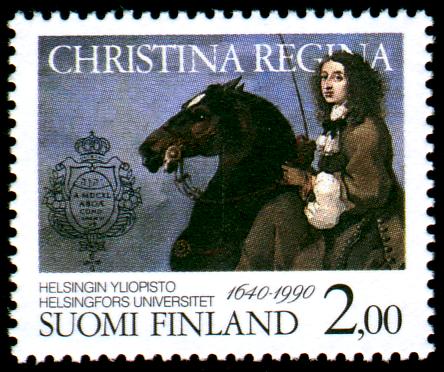
In this post I have only been able to offer the lightest touch on few aspects of Christina’s eventful life and her continuing influence. However, in closing; I hope that when you see van Auden-Aerd’s depiction of her funerary procession in the Europe Galleries, you will be able to consider, not just the image of a dead woman but also an unusual life lived with enthusiasm and vigor. Christina appears to have been, as ‘Le Grande Mademoiselle’ (Anne Marie Louise d’Orléans, Duchess of Montpensier) recalled of meeting her, ‘in all respects a most extraordinary creature’.
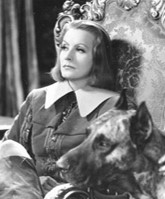
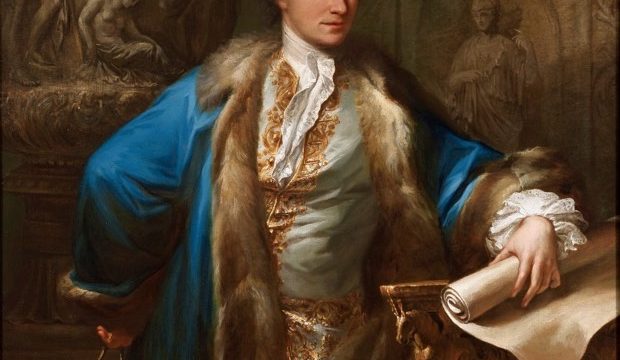
What a beautiful reflection of a woman, a queen, and a scholar. Such a breathtaking life leaves one, speechless. I am so glad to have watched the movie, The Girl King. That is what sparked my interest in learning more about her. Your depiction was heart warming and informative, thank you.
Dear Dawn,
I would like to make a comment on your first portrait of Queen Christina in this blogg. It is most probably painted by Elbfas, but not as late as 1642-43. His last payment for a portrait of her was in November 1641, when he recieved 108 Taler, probably as a payment for a full-length portrait of Christina that is now in the City Hall of Stockholm.
The portrait shown above was probably painted in 1635-1636, or at the latest in 1637. That can be seen by a comparision with other portraits from the same time but above all by her clothes, especially the low lace collar, which is upraised behind her back. That type of collar was later replaced by a broad lace collar which was laying down over the sholuders, as the one that can be seen in a portrait of Chistina in the Gymasium of Västerås in Sweden, which is with certainty dated till 1637.
Yours sincerely,
Inga Lena Ångström Grandien,
a Swedish art historian with a special interest in portraits of Queen Christina